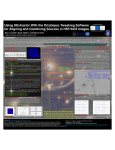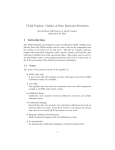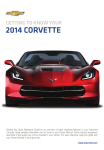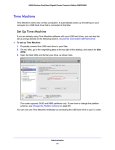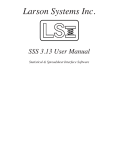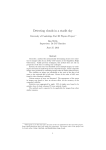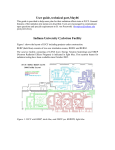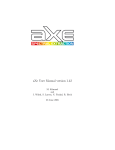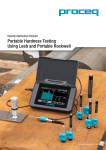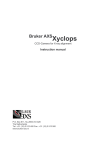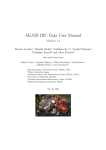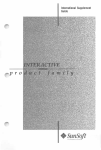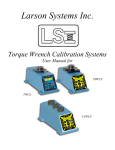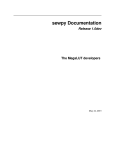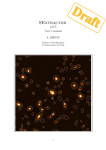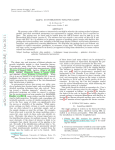Download Basic Use of SExtractor Catalogs With TweakReg - II (ISR 15
Transcript
Instrument Science Report ACS 2015-05
Basic Use of SExtractor
Catalogs With TweakReg - II
Ray A. Lucas
May 27, 2015
ABSTRACT
The TweakReg task in the DrizzlePac software package for aligning and drizzling images
is an effective tool for the initial processing of HST images. However, the internal
object-finding software which it uses to generate catalogs to be used for object matching
and alignment, ImageFindPars, is based on the well-known stellar-oriented daofind
routine, and though it is appropriate for most images, there are some for which the task
is not well-suited, such as some extragalactic fields which have lots of galaxies but
almost no stars, and in some cases, if taken over long time-baselines, even the few stars
present may have moved due to proper motion, thereby making them unsuitable for use in
image alignment. In that case, other object-detection programs such as SExtractor can
be used to generate external catalogs of primarily galaxies which can then be fed to the
TweakReg task. Even multiwavelength morphological differences may make some
galaxies less suitable than others for use in image alignment and registration. The basic
use of simple external SExtractor catalogs with the DrizzlePac TweakReg task is
described here, using ACS/WFC data as an example. This includes updating geometric
distortion files, initial drizzling to make cosmic ray-cleaned images, the set-up and use of
required SExtractor files to generate SExtractor catalogs, basic manipulation of those
catalogs, and their use with the TweakReg task in the DrizzlePac package. More options
are explored for iteratively improving the astrometric solution than in Paper I (ACS ISR
2015-04) but this still represents an intermediate level of sophistication in methods. This
paper introduces several methods but the ultimate best methods can vary with the nature
of the objects and the data, etc. and are for the user to explore. Also, the use of
crclean.fits images may be more suited to ACS/WFC and WFC3/UVIS than WFC3/IR.
1
Introduction
Although the stellar-oriented, built-in object detection routine, ImageFindPars, in
DrizzlePac’s TweakReg task, can be quite useful for aligning images in most fields
which have plenty of stars for alignment, there are some situations in which there are not
many or any stars in the images to be aligned, and in which even those few stars may
have moved due to proper motion if the images were taken over a long enough timebaseline, such as archival data from different observing programs on the same target
separated by some number of years. Additionally, morphological differences in
multiwavelength sets of images of galaxies may even make some galaxies less suitable
than others as reference objects for registration and alignment. In this example, we are
addressing the simplest case, merely using SExtractor software to generate very simple
external catalogs to feed to the TweakReg task for alignment of images.
SExtractor, however, needs good, clean images to produce better results, but images,
by default, usually have many cosmic rays in them which complicate the tasks of object
detection, position measurement, and ultimately, image alignment. Although new
developments with the default ImageFindPars task and TweakReg allow for use of the
data quality (DQ) arrays to ignore or eliminate the use of objects affected by cosmic rays,
SExtractor does not use the DQ array information, hence the need for first making the crclean.fits images.
In terms of ideal conditions for attacking this problem, if such images are available,
it is always best to start by aligning and combining images from the same visit (the same
guide star acquisition) and in the same filter, and then later expanding that to aligning and
combining across visits in the same filter, and ultimately across both different filters and
different visits. Therefore, in general, if designing an observing program, it is also a
good idea to keep this in mind as an ideal set-up for aligning and drizzling images
together. If you can have multiple images of similar exposure time in the same filter and
same visit, then do that. It may not always be possible, but that is a good, ideal situation.
In this example, we have taken an even simpler approach, where all of the images in
all of the filters were taken in one single visit. We have used the ACS SM4 ERO images
of the galaxy cluster Abell 370 from HST program 11507 (PI: Noll). The data were
taken in 2009, not long after SM4, and are comprised of 6 dithered ACS/WFC images in
each of three filters, F475W, F625W, and F814W. A formatted version of the Phase II
file may be seen at http://www.stsci.edu/hst/phase2-public/11507.pro via the standard
program information web pages. We do not push the limits of everything we could try
nor the limit of what could be achieved in this example, but we show enough to give an
idea of how the solution can be improved.
2
Process
We will first (1) update the WCS and geometric distortion in each of the images - a
process specific to ACS/WFC which currently has to be done manually, but which will
be automated as part of the routine pipeline by late 2015 as part of OPUS 2015.3. Next,
we will (2) make an initial run of AstroDrizzle on the same-filter, same-visit images to
generate cosmic ray-cleaned images called *_crclean.fits which will be used in (3)
generating the SExtractor catalogs. After generating the SExtractor catalogs from the
crclean.fits images, we will (4) feed those catalogs to TweakReg, and (5) manipulate the
input catalogs if needed/desired, iterating in each filter internally as needed without
updating the headers until we have a solution which we deem more acceptable for each of
the images in a given filter, and then moving on to the next filter, until we have a solution
which seems reasonable for each filter. (Remember that in this case, all the data were
taken within the same visit.) At that point, we will (6) re-run the TweakReg task for the
images in each same-filter, same-visit set, this time updating the header information with
the solution required to align all the images in a given filter for that visit.
Although perhaps not fully covered in this example since there are other examples
regarding this, in typical usage and situations, the resulting per-filter-aligned images can
then be (7) drizzled together again, and the drizzled output used as a reference image to
be fed to the DrizzlePac TweakBack task to update the headers of all the images in all of
the filters to that reference image, after which they can all be drizzled together on a perfilter basis with the resulting output also being aligned across both all visits and all filters.
We will show examples of task parameter files, of SExtractor set-up files’ input
settings and their content, of the various output catalogs and their content and format, and
show some possibly-helpful means of manipulation of the output catalogs, etc. as well as
giving some advice as to other things one may try in order to make the solution better
since this paper is merely describing a general approach and not detailing all of the
possibilities.
Step 1: Update the WCS Information for Geometric Distortion
This first step will only be required to be done manually until late 2015, when this
part of the process is to be incorporated into the routine pipeline processing in OPUS
2015.3. Until that time, one must download new reference files for the IDCTAB,
NPOLFILE, and D2IMFILE and use the setval task to first update the keyword values
for the IDCTAB, NPOLFILE, and D2IMFILE keywords in the science image headers,
and then use the task updatewcs to apply the corrections from the new files to the science
3
images. Bear in mind that if you update one of these files, you should update all three, as
they are intended for use together as an ensemble. Throughout this example, it is assumed
that the standard pipeline-calibrated, de-striped, CTE-corrected *_flc.fits images are
being used, and those are the ones to which these geometric corrections are being applied.
This process is currently described in more detail on the ACS Distortion web page at
http://www.stsci.edu/hst/acs/analysis/distortion and can briefly be summarized thus, as
taken from the text of that page:
--> from astropy.io import fits
--> fits.setval(image_filename, 'IDCTAB',
value='/location/of/IDCfile/IDCFILEname.fits')
--> fits.setval(image_filename, 'NPOLFILE',
value='/location/of/NPOLfile/NPOLFILEname.fits')
--> fits.setval(image_filename, 'D2IMFILE',
value='/location/of/D2IMfile/D2IMFILEname.fits')
--> from stwcs import updatewcs
--> updatewcs.updatewcs('*flc.fits') # update the WCS in
the header.
Also, as per instructions on that page, be sure not to use the updatewcs task again as part
of your subsequent TweakReg and AstroDrizzle runs as you try to find an optimal
alignment since re-running the updatewcs task will over-write any previous corrections
you have made with your initial run and subsequent iterations of TweakReg. Instead,
use the updatehdr keyword with value set to “False” (“No”) during your TweakReg
iterations and then change it to “True” (“Yes”) when you have found a solution you like
and are re-running TweakReg for the last time.
Step 2: Initial AstroDrizzle Run to Make Cosmic-Ray-Cleaned Images
In this and subsequent sections on AstroDrizzle and TweakReg, you may run
python commands or use the Teal interface to execute the tasks. These are described
elsewhere, and we will merely describe the non-default parameter values which have
been selected.
In order to make initial cosmic-ray-cleaned images to feed to SExtractor, we make a
separate directory for all the images in a given filter for that visit and place the images for
that filter into it. Then, we make use of the existing WCS information in the science
4
image headers to first combine the images on that same-visit, same-filter basis. Since we
have 6 images in the same filter per visit, we use combine_type = iminmed in making the
median image, and driz_cr_corr = True. If desired, a “final” drizzled science image
(though substandard without any better alignment being applied) with an associated
weight image of type IVM can be created using driz_combine = True and final_wht_type
= IVM, as is needed for input to SExtractor, but for now we will ignore the use of weight
maps with SExtractor in this basic example. The use of weight maps with SExtractor, a
usage which tends to yield better positional accuracy, though not inherently difficult, is a
more advanced topic which will be addressed further in, for example, Hubble Frontier
Fields technical documentation. For now, for the main points being made in our basic
example, we do not need an image of this sort, although use of weight images with
SExtractor often, with iteration, ultimately tends to yield better positional accuracy. We
will therefore in this example continue on with the use of the *_crclean.fits images which
we have now created with our initial AstroDrizzle run, which has produced a single
*_crclean.fits image for each single input *_flc.fits image, so that there is a one-to-one
correspondence between these two image types. Appendix A lists our input parameters
in detail for our initial run of AstroDrizzle to create these *_crclean.fits images.
Step 3: Run SExtractor to Produce Object Catalogs for Alignment
Here we assume that the reader has either already downloaded and installed
SExtractor according to standard directions or will do so, and will refer as needed to
further documentation referenced in this article. We have used SExtractor version 2.8.6
in this case. It handles multi-extension FITS files in a more user-friendly fashion than
earlier versions in frequent use such as version 2.5.0. In SExtractor version 2.5.0, the
software will run on multi-exension FITS images, but it runs on all extensions, and it is
then necessary to make the extension number one of the outputs and to then filter out the
catalogs generated for all other extensions except for the one(s) desired. In contrast, in
SExtractor version 2.8.6, one may run the software on a single image extension at a time,
but there is an offset which must be applied. Although in SExtractor version 2.5.0 output,
the image extensions [1] and [4] correctly refer to the two science image extensions of
primary concern for measuring and cataloging object positions, in SExtractor version
2.8.6, one must refer to those extensions as [0] and [3] respectively when running
SExtractor on those two science image extensions.
When running SExtractor, 4 basic set-up files are involved: (1) default.sex, which is
where parameters for minimum object size, background filters, detection threshold levels,
photometric systems and zeropoints, seeing_fwhm, and pixel_scale (both only used for
SExtractor’s class_star galaxy-star discriminator), and other similar items fundamental to
5
the objects themselves are defined, (2) default.conv, which applies convolution filters of
the user’s choice (gaussian, Mexican hat, etc.) in object detection and characterization,
(3) default.nnw, which defines a neural network for object classification, and (4)
default.param, which defines the quantities to be output into the catalog from the
SExtractor run. These input files are automatically called when SExtractor is run.
Examples of these 4 input files are shown in Apendices B, C, D, and E. In our usage
here, we have used mostly default parameters in the creation of these simple, basic
catalogs, but we have changed a few items which we will highlight. We also include
some commentary on the parameter values in annotations within the example files.
To run SExtractor, the default.* files must be in the working directory, and set up
with parameter values as desired. Then, bearing in mind the offset in extension number
(assuming use of SExtractor version 2.8.6 as was used here), and specifying ‘’ as the
catalog name and the checkimage name in the default.sex file (as shown in Appendix B),
the commands to issue are simply of the form below (the two-line commands wrap)
sex -catalog_name jabu01fvq_crclean_ext1.cat -checkimage_name
jabu01fvq_crclean_ext1_check.fits jabu01fvq_crclean.fits’[0]’
sex -catalog_name jabu01fvq_crclean_ext4.cat -checkimage_name
jabu01fvq_crclean_ext4_check.fits jabu01fvq_crclean.fits’[3]’
etc.
such that a separate catalog and checkimage is generated for each of the two chips for
each image since the TweakReg task expects its input in that format. You could instead
just issue the commands above in the format of “sex jabu01fvq_crclean.fits’[0]’ “ if you
edited the name of the output catalog and checkimage as appropriate in the default.sex
file before each issuance of the command to run SExtractor.
As determined by the default.params file, the specific format of the output catalog
in this example is given at the head of the output catalog, and is the following, with the
first number on the left representing the column number in the output:
#
#
#
#
#
#
1 X_IMAGE
2 Y_IMAGE
3 MAG_AUTO
4 CLASS_STAR
5 NUMBER
6 FLAGS
Object position along x
Object position along y
Kron-like elliptical aperture magnitude
S/G classifier output
Running object number
Extraction flags
6
[pixel]
[pixel]
[mag]
The most critical components of the output are x and y measurements of the objects, plus
magnitude or flux information. Depending on whether the flux values in the images are
expressed in terms of counts or counts per second, the magnitude zeropoint may be
expressed in different ways. In the case of this example, the images were in counts, so the
magnitude zeropoint was calculated as (M + 2.5 log (expoure time)) where M was a
value obtained from http://www.stsci.edu/hst/acs/analysis/zeropoints/zpt.py which is the
web page for the ACS zero point calculator. This will enable later optional automatic
trimming (within TweakReg) of the input list for matching based on magnitude limits. In
this case, the ST Mag system was used, but it could easily have been any of several other
magnitude systems which are offered as options in the ACS zero point calculator. The
important thing here is the relative difference in magnitudes between objects within any
given system since it is used in TweakReg for setting faint and bright limits on the list of
objects to include for matching.
If the information about FWHM and pixel scale was used such that SExtractor
stellarity values are valid, then that quantity may also be used to eliminate some objects
from the matching solution, if desired, by the use of awk commands, etc. Other options
for trimming the object lists in the input catalogs include trimming boundaries of some
number of pixels in x and y around the edges of the chips, also by the use of awk
commands. An example of this will be shown in the section on Step 5, Iterating in
TweakReg.
It is always a good idea to actually look at some catalogs overplotted on your images
to see if they actually seem to be reasonable, picking up real objects in a reasonable
magnitude range, getting reasonable-looking centers for them, and discriminating well
between sources in complex areas with multiple objects, etc. To do this, with the use of
awk commands, for example, on can easily turn a copy of input catalogs into files of ds9
region format and then overplot them on the single-chip images. Examples of two of our
initial catalogs are shown in Figures 1 and 2, representing the 2 different chips of one of
the *_crclean.fits images, while Figures 3 and 4 show some of the details.
7
Figure 1: Extension 1 of one of the images, above, and the original SExtractor output
catalog overplotted in green.
Figure 2: Extension 4 of one of the images, above, and the original SExtractor output
catalog overplotted in green.
8
Figure 3: Close-up, above, showing detail of some of the SExtractor catalog objects,
including some in the lensed arc.
Some spurious objects are visible in the lensed arc in Extension 1 and in the bright
star in Extension 4. However, most catalog object entries look real and reasonable when
looking at the objects in the images on which they are overplotted. Such sanity checks are
always important to make, and can also help inform choices of objects to delete in an
attempt to find a better solution when doing iterative TweakReg runs.
Figure 4: Close-up, above, showing detail of some of the SExtractor catalog objects,
including some which are artifacts associated with the bright star.
9
Step 4: Feed SExtractor Catalogs to TweakReg
Once you have created the SExtractor catalogs on the basis above (a separate catalog
for each chip of each image), you can then feed them to the TweakReg task in order for
it to do its source matching and alignment. It is usually an iterative process, so you will
usually run TweakReg multiple times with the updatehdr keyword set to “False” (No”)
during those iterations, and only set it to “True” (“Yes”) in a final re-run of TweakReg
when you have found a solution which you consider acceptable and have set the task
parameters and version of the input catalogs to match the conditions which produced the
most desired results. Remember also that you should not update the WCS again, or you
will undo the geometric corrections you have applied earlier.
To begin the alignment process, TweakReg expects a file which lists the images to
be aligned, the *_flc.fits images, along with the catalogs from each chip of the
*_crclean.fits images in the form “flc.fits crclean-chip1.cat crclean-chip2.cat” thus:
jabu01fvq_flc.fits jabu01fvq_crclean_ext1.cat jabu01fvq_crclean_ext4.cat
jabu01gfq_flc.fits jabu01gfq_crclean_ext1.cat jabu01gfq_crclean_ext4.cat
jabu01gmq_flc.fits jabu01gmq_crclean_ext1.cat jabu01gmq_crclean_ext4.cat
jabu01gsq_flc.fits jabu01gsq_crclean_ext1.cat jabu01gsq_crclean_ext4.cat
jabu01gyq_flc.fits jabu01gyq_crclean_ext1.cat jabu01gyq_crclean_ext4.cat
jabu01hcq_flc.fits jabu01hcq_crclean_ext1.cat jabu01hcq_crclean_ext4.cat
This file may be called by any name, as long as that name is given as the parameter value
to the “catfile” parameter in the TweakReg task. In this case, even though we are feeding
it our own external SExtractor catalogs, we have chosen to name it just as the TweakReg
task names it by default when it uses its own internally-generated catalogs from the
ImageFindPars task, “coords_catfile.lis”.
We begin the iterative process by running TweakReg with mostly default parameter
values to first see what kind of result we get that way, and then iterate further if we feel it
is needed, or just to see if we can easily improve on the initial solution. Our initial run
task parameters for TweakReg are shown in Appendix F. Note that, though we don’t use
it directly, just for our own informational purposes, we produce a differently-named (by
version number and other distinguishing characteristics, etc.) shift file and wcs.fits file
for each tentative run even though we are not updating the header with any improved
solutions at this stage. This allows us to get a better sense of how consistently different
iterations are finding very nearly the same shifts, or where they may deviate more
significantly, and to see the x and y rms values for each image in that run, to which we
can refer, along with the plots for each run which we also save for comparison, naming
10
them by the most distinguishing part of their rootname and iteration or version number
and any other particular differences we made in the input catalogs, etc.
An example of the shift file we obtain from our initial run is here, below. From left to
right, the quantities reported are image, x-shift, y-shift, rotation, scale, x-rms, and y-rms
(x and y shifts and rms units are in pixels, rotation is in degrees).
# frame: output
# refimage: shifts-ver1_wcs.fits[wcs]
# form: delta
# units: pixels
jabu01fvq_flc.fits 0.000000 0.000000
jabu01gfq_flc.fits 0.022882 -0.024646
jabu01gmq_flc.fits 0.082594 0.001245
jabu01gsq_flc.fits 0.081501 -0.004551
jabu01gyq_flc.fits 0.169839 0.060228
jabu01hcq_flc.fits 0.133796 0.109905
0.000000 1.000000
359.999418 1.000002
359.998965 1.000009
359.998707 1.000003
359.998981 1.000007
359.999174 1.000007
0.000000 0.000000
0.160056 0.158230
0.165687 0.163800
0.139776 0.153342
0.146863 0.156113
0.147139 0.157516
We also obtain plots for each of the images being compared to its reference, which by
default is the first image in the series. Examples of the types of plots we obtain for one of
the images in the series are shown below in Figures 5, 6, and 7.
Figure 5: Typical initial
histogram of offsets.
Figure 6: Typical initial
vector plot of residuals.
Figure 7: Typical initial
x,y rms (pixel) residuals
Step 5: Iterating in TweakReg
As mentioned above, one may want to see if any better solutions can be easily
obtained, and that some cuts to the input object lists in the catalogs may be made using
the built-in flux or magnitude limit parameters within the TweakReg task itself. And, as
also mentioned above, an awk command to trim catalogs and select objects based on
greater or lesser stellarity may also be used. Early-type galaxies (ellipticals, etc.) may be
better sources to use for alignment because they are less prone to changes in
11
morphological appearance over the wavelength range of images in several filters, but
stars may also be bad sources to use for alignment if saturated, or if spurious sources
were found around them in their diffraction spikes or airy rings or other artifacts in the
PSF, or if they have a high enough proper motion and if images were taken far enough
apart in time that the stars have moved between the frames. (This is not the case here in
this example, and it is generally only the case when observations are separated by some
number of years for the highest proper motion stars in most fields.) Appendix G
represents an example of a TweakReg parameter file from one of the iterations. If we
manually deleted any objects from the object list, it will not contain parameters for that.
One very important thing to mention regarding automatic trimming of the input
catalogs within TweakReg based on flux limits or magnitude limits is the correct usage
of the maxflux and minflux parameter values in TweakReg. If the catalog values are
simply in flux units, then maxflux and minflux may be used simply and intuitively just as
they would seem to imply. In the case of using regular flux measurements, a larger
number corresponds to a brighter source and a smaller number corresponds to a fainter
source. However, if the SExtractor catalog flux values have been converted into
magnitudes as is the case in this example, then the use of maxflux and minflux can be a bit
counterintuitive. It must be remembered that brighter magnitudes correspond to smaller
numbers and fainter magnitudes correspond to larger numbers, so that, when using
magnitudes as input in the catalog files, the software is written and works such that you
must use what seems to be a reverse order for maximum and minimum, corresponding to
the size of the number rather than the magnitude of the source. For example, when using
magnitudes rather than regular flux measurements, you would specify maxflux = 24.0 and
minflux = 20.0 to select and trim the magnitude range to include only sources from
magnitude 20.0 to 24.0 in your input SExtractor catalog for use in matching sources
although the name of the parameters make that seem counterintuitive and to prefer the
opposite. One will encounter crashes with errors if using the values for these parameters
in the same sense for magnitudes as for regular fluxes.
Another kind of object filtering one may want to do is to trim the objects around the
edge of the chips if they happen to be very close to the edge or suspect in those areas for
some other reason. This may be useful if there are areas in the *_crclean.fits images
which did not have overlap with other images and there are areas around edges which
were not effectively cleaned of cosmic rays and those have dominated the object lists
there, or if there are other spurious or questionable objects detected along the edges of an
image. For example, given the specific format of our output SExtractor catalogs which
was set by what we have defined in our default.params file, the awk syntax for trimming
objects in a 100-pixel border around the edges of the ACS/WFC chips which are 4096 x
2048 pixels each would be this. (NOTE: The line below wraps.)
12
awk '($1 !~ /#/ && $1>100 && $1<3996 && $2>100 && $2<1948)' jabu01fvq_crclean_ext1.cat > jabu01fvq_crclean_trimv1_ext1.cat
The $1 represents the column of x values and $2 the column of y values. From this
example, one may also anticipate part of the command necessary to trim the list based on
stellarity, etc. except for which stellarity values to use as a cut-off.
Whether we trimmed our input catalog object lists by magnitude ranges or by
trimming some portion of a border area around the chip edges or by stellarity or manually
by some other means and based on some other criteria, to use the trimmed object catalogs
in TweakReg, the resulting new catalogs must then be referenced in the TweakReg
catfile parameter in a new file like the coords_catfile.lis which was used for the original
TweakReg run. We could contineu to call it coords_catfile.lis or any other name we
wish, but to most accurately describe it, we’ll call it coordstrimmed_catfile.lis, and it has
the same format as the original coords_catfile.lis, but references the new, trimmed
catalogs instead, as below. (NOTE: The lines below wrap, making a total of 6 lines.)
jabu01fvq_flc.fits jabu01fvq_crclean_trimv1_ext1.cat
jabu01fvq_crclean_trimv1_ext4.cat
jabu01gfq_flc.fits jabu01gfq_crclean_trimv1_ext1.cat
jabu01gfq_crclean_trimv1_ext4.cat
jabu01gmq_flc.fits jabu01gmq_crclean_trimv1_ext1.cat
jabu01gmq_crclean_trimv1_ext4.cat
jabu01gsq_flc.fits jabu01gsq_crclean_trimv1_ext1.cat
jabu01gsq_crclean_trimv1_ext4.cat
jabu01gyq_flc.fits jabu01gyq_crclean_trimv1_ext1.cat
jabu01gyq_crclean_trimv1_ext4.cat
jabu01hcq_flc.fits jabu01hcq_crclean_trimv1_ext1.cat
jabu01hcq_crclean_trimv1_ext4.cat
It should also be remembered that, although automation of object inclusion or
exclusion in the source lists is generally most desirable, if need be, the input object lists
can even be manually edited to include or exclude any particularly useful or troublesome
objects, as the case may be. Quoting from Paper I (ACS ISR 2015-04): “You may also
want to try deleting from your catalogs troublesome objects which have high residuals as
shown in the TweakReg plots, but that, too, can be tricky, and the size of an object’s
residuals may vary some from image to image and catalog to catalog. In general, it is
perhaps better to use other methods, such as scripted awk commands to remove such
objects on the periphery or elsewhere, or within specified magnitude ranges or stellarity
13
values, or ellipticity, or galaxy morphology type, etc. (Small elliptical galaxies may be
better than galaxies with more complex morphology when having to compare across
different bandpasses, for example.)” However, simple removal of objects with high
residuals may also work very well since they are, after all, seemingly problematic in at
least some of the images and catalogs. In fact, although a tedious process which most would not want to try in most
circumstances, in the case of badly mis-aligned images with grossly bad pointing info in
the header, etc. due to something like a guide star problem during acquisition, manual
measurement and generation of catalog entries for objects in such an image which are
then inserted into the input catalog(s) can be an effective way of correcting the header
info in those images and bringing them into a close enough spatial concordance with the
others that the TweakReg task can then be used in subsequent iterations to more finely
align them to other images at similar pointings. In fact, in even more labor-intensive
fashion, an entire manually-measured and manually-edited list of catalog object positions
could be created for each image and run through TweakReg in this manner if it was
advantageous, but that is, as said, a very labor-intensive exercise which is usually much
better automated in some way if possible, and so we only mention the possibility of it
here and leave the rest to the reader as an exercise if so desired.
Step 6: Re-running TweakReg to Update the Headers of Files to Be Aligned
Once a solution has been found that the user deems acceptable, or at least the best
possible to achieve with the current process, if it is desired to continue with that
alignment, the TweakReg task must be run once more with the updatehdr keyword set to
“Yes” in order to apply the corrections to all the *_flc.fits images in that same filter/same
visit set. Appendix H shows a version of such ultimate TweakReg parameters, with the
main difference being that one keyword value for updatehdr being set to “Yes” (“True”).
Step 7: The Remainder of the Process
We will not cover all of the rest of the process in detail here, but will merely briefly
describe it since it is re-integrated with the rest of the process that would normally be
used had the input catalogs been those generated internally in TweakReg via the use of
the built-in ImageFindPars task.
Once you have internally aligned each same visit/same filter combination of images,
you can then drizzle a set of them in one filter to a “final” *_drc.fits image which you can
then use as a reference image to transfer the solution to all the _flc.fits images across all
filters and all visits via the DrizzlePac TweakBack task. Those images can then all be
14
drizzled together on a per-filter basis, with the resulting images all being aligned
together. This process is described elsewhere in other examples and documentation and
will not be described further here. The reader is referred to that documentation instead.
The Best SExtractor Options
Although varying SExtractor object detection and measuring parameters and also
trimming catalog lists by magnitude limits, spatial chip-edge limits, and stellarity, as well
as by manual massaging of individual case-by-case circumstances of various sorts which
may help to make a final solution somewhat better, it is generally the case that the most
effective way to make the coordinate measures of objects the most reliable and consistent
in SExtractor and improve the solutions by a significant amount is to incorporate the use
of the relevant weight map (always in IVM format, as required by SExtractor) when
detecting and measuring the positions of objects. The use of a weight map can easily be
specified on the command line when running SExtractor. It can potentially be very
helpful in almost all circumstances, but perhaps especially so in cases such as when
measuring objects taken across different visits and in mosaics or stacks where there are
areas of varying depth and signal-to-noise. This practice will be addressed in more detail
elsewhere, including in the Frontier Fields technical documentation and scripts when
published.
Using inverse variance (IVM) weight maps when available is probably the single
most beneficial improvement one can make in obtaining better coordinates and
registration. Along with that, the kinds of things described in this ISR including trimming
the list of objects by removing fainter objects, extraordinarily bright objects such as
bright stars, objects on the edges of the image which may not have been measured as
well, objects with complex morphologies which may also vary more greatly from
bandpass to bandpass (although they may be OK internally within a single filter), and, in
the case of images taken over a long time baseline, removal of stars which may have
proper motion - all of these and still more things represent areas which may be
investigated/tried for possible improvement of the solution. All datasets and
combinations of datasets are different and each present their own unique challenges.
Conclusions
We have shown examples of parameter files for DrizzlePac’s AstroDrizzle and
TweakReg tasks as they may be used in preparing cosmic ray-cleaned images for the use
of SExtractor on them, and in incorporating SExtractor-produced object catalogs for use
in image alignment and registration. We have also shown examples of the four basic
SExtractor startup files, default.sex, default.conv, defaul.nnw, and default.params as
15
they might be used on datasets of this sort. We have also shown examples of other files
such as the SExtractor catalog format and the image plus catalog file lists such as
coords_catfile.lis needed in the process. Finally, as an aid to using these tools, we have
also given advice on some general guidelines for items such as suggested values for some
critical parameters, and we have given advice on some things to explore in iterative
efforts to improve astrometric solutions beyond their initial values, to see if any
improvement is readily possible.
Recommendations
In situations such as we have described where SExtractor is needed, we recommend
the creation of cosmic ray-cleaned images as input for SExtractor. We recommend the
use of SExtractor version 2.8.6 or later. In SExtractor’s default.sex file, the back_size
should be a little larger than an average, typical small, faint galaxy in number of pixels. A
value of 64 is a good value for small HUDF-like galaxies, together with a back_filtersize
of 3 or so. A detect_minarea of 3 and detect_thresh of 7 are similarly reasonable values,
and analysis_thresh can sometimes also be useful for experimentation. Cuts in the lists
based on magnitude, (x,y) position, stellarity, and several other edits may help make the
solution better, but ultimately, the use of inverse variance weight maps is one of the best
aids to better solutions.
Acknowledgements
We are grateful to Mihai Cara, Warren Hack, and fellow members of the STScI
DrizzlePac/AstroDrizzle Working Group for advice and a careful reading of this paper.
References
SExtractor:
SExtractor: http://www.astromatic.net/software/sextractor
Bertin, E., & Arnouts, S., 1996: SExtractor: Software for Source Extraction, Astronomy & Astrophysics
Supplement 317, 393
Bertin, E., SExtractor v2.13 User’s Manual, at
https://www.astromatic.net/pubsvn/software/sextractor/trunk/doc/sextractor.pdf
Akhlaghi, M., 2012, Notes on SExtractor 2.8.6, at
http://www.astr.tohoku.ac.jp/~akhlaghi/sextractor_notes.html
Holwerda, B., SExtractor for Dummies, at
http://astroa.physics.metu.edu.tr/MANUALS/sextractor/Guide2source_extractor.pdf
DrizzlePac tasks and usage:
DrizzlePac tasks and usage:
Gonzaga et al., 2012, The DrizzlePac Handbook (Available on-line.)
http://documents.stsci.edu/hst/HST_overview/documents/DrizzlePac/DrizzlePac.cover.html
16
STScI DrizzlePac Web Site
http://www.stsci.edu/hst/HST_overview/drizzlepac
AAS Posters at DrizzlePac web site:
Lucas, R.A., 2012, AstroDrizzle: Utilizing New CALACS Products, AAS-Anchorage,
Alaska http://www.stsci.edu/hst/HST_overview/drizzlepac/resources/ral_aasanchorage_2012_template-v7_Lucas.pdf
Lucas, R.A., Hilbert, B., and Hack, W. 2013, Using SExtractor With the DrizzlePac
Tweakreg Software for Aligning and Combining Sources in HST/ACS Images, AASLong Beach, California
http://www.stsci.edu/hst/HST_overview/drizzlepac/resources/Lucas_AAS.pdf
ISRs
Lucas, R.A. and Hilbert, B., 2015, Basic Use of SExtractor Catalogs With TweakReg –
I, Instrument Science Report ACS 2015-04
17
Appendix A – Initial AstroDrizzle Input Parameters:
18
(Initial AstroDrizzle Input Parmeters – continued)
NOTE: We have turned on Step 7, the final drizzle, here, for our own curiosity, even
before the fine alignment with TweakReg, just to see how a rough first version of a final
image might look in this case where all of the images in all of the filters were taken in the
same visit, but this need not be done for the process we have described here.
19
Appendix B – Basic SExtractor default.sex file Parameters:
( Continued on next page)
20
(SExtractor defaul.sex file – continued)
Appendix C – Basic SExtractor default.conv file
21
Appendix D – Basic SExtractor default.nnw file
22
Appendix E – Basic SExtractor default.params file
23
(SExtractor default.params file – continued)
NOTE: In Appendix F, G, and H, updatehdr may sometimes be set to “True”/“Yes” or
“False”/”No” depending on which version of the software and which interface you are
using. Also, Appendices G & H are only examples. They may not represent your last 2
TweakReg runs since you may conceivably try still more things to improve solutions.
24
Appendix F – Initial TweakReg Run Parameters:
25
Appendix G – Penultimate (Last Iteration) TweakReg Run Parameters:
26
Appendix H – Ultimate TweakReg Run Parameters:
27



























